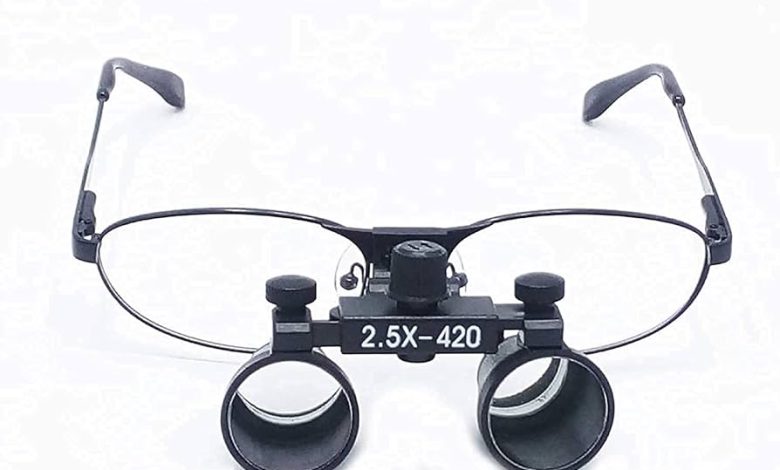Comparison between 2.5x vs 3-3.5x Magnifying Loupes: Implications for Different Specialities

Magnifying loupes have become an integral tool in various fields requiring precision, particularly in specialities within the medical and dental professions. These devices enhance visual accuracy for intricate tasks, and are essential for professionals who need to maintain a high level of detail in their work. In this comparison, we delve into the nuances between 2.5x magnification loupes and those that offer 3-3.5x magnification, analysing their implications for different specialties.
Understanding Magnifying Loupes
Magnifying loupes are optical devices designed to provide a clear, magnified view of small objects or details. They are commonly worn by professionals to either enhance their visual acuity or to reduce strain during lengthy procedures. Loupes vary in their magnification power, which is usually denoted as a number followed by an ‘x’, representing how many times larger the viewed object appears compared to the naked eye.
2.5x Magnification Loupes
Loupes with a 2.5x magnification are widely considered an entry point for professionals exploring the benefits of enhanced vision in their practice. They provide a balance between magnification and field of view, allowing users to see a larger area in focus without the need to move their head significantly. This level of magnification is sufficient for many general tasks, where a moderate enhancement can make a considerable improvement in accuracy and comfort.
3-3.5x Magnification Loupes
As the demands of a specialty increase, so does the need for greater levels of magnification. Loupes that offer 3-3.5x magnification level bring smaller details into sharper focus, an essential factor for tasks that require an advanced degree of precision. However, these loupes tend to have a smaller field of view — a trade-off for the increased magnification. Consequently, they may require more head movement to view different areas of the work field.
Implications in Dental Specialties
In the realm of dentistry, the use of dental loupes is widespread owing to the intricate nature of dental procedures. With a 2.5x magnification, general dentists are equipped to perform routine check-ups, cleanings, and basic restorative work with enhanced visual acuity. These loupes help to improve posture by allowing dentists to maintain a comfortable position while examining or working on a patient.
However, dental specialists who perform more complex procedures, such as endodontists or periodontists, may find the higher magnification of 3-3.5x loupes more beneficial. This level of detail assists in identifying fine structures of the teeth and gums, and is particularly useful when working within the narrow confines of the tooth structure, like in root canal therapy.
Implications for Surgical Specialties
Surgeons, too, need utmost precision in their field, whether they are conducting microsurgery, ophthalmic surgery, or other intricate procedures. A higher magnification facilitates them in the accurate manipulation of tiny structures, suture placement, and the delicate dissection of tissues. While they may sacrifice some breadth of view, their work often demands the highest level of detail that the greater magnification of 3-3.5x loupes can provide.
Choosing the Right Magnification
The choice between 2.5x and 3-3.5x magnifying loupes largely depends on the nature of the specialty. General practices that require wider views and less intense magnification are well-served by 2.5x loupes. On the other hand, professionals involved in micro-specialities would benefit from the higher magnification provided by 3-3.5x loupes, despite the smaller field of view.
Comfort and Usability
When considering magnification levels, one must also evaluate comfort and usability. Higher magnification loupes are often heavier due to the more complex lens systems. Therefore, the weight and fit of the loupes are crucial for practitioners who wear them over extended periods, as discomfort can lead to distraction and fatigue.
Lighting and Optical Quality
With increased magnification, the importance of adequate lighting and optical quality becomes paramount. A well-lit field of view can significantly enhance the effectiveness of the loupes, and high-quality optics can help prevent eye strain and provide a distortion-free image.
Impact on Learning and Development
For students and professionals in the early stages of their career, starting with a lower magnification can be beneficial. It allows the development of hand-eye coordination and an understanding of spatial relationships without becoming overly reliant on the tools. As skills advance, moving to higher magnification levels may be a natural progression.
Future Considerations
As technology evolves, so do the options available for magnifying loupes. Advances in optical engineering can lead to lighter, higher magnification loupes with a wider field of view, potentially offering the best of both worlds. However, each professional must weigh the current options and make an informed decision based on their specific needs.
Conclusion
Ultimately, the decision between 2.5x and 3-3.5x magnifying loupes should be made in consideration of one’s specialty, the complexity of tasks, and personal preference for comfort. Whether in dental, surgical, or other precision-demanding fields, the right pair of loupes can make a significant difference in practice efficiency, quality of work, and practitioner well-being. With careful consideration, professionals can choose the magnifying tool that will best amplify their skillset and meet the demands of their unique field of expertise.




